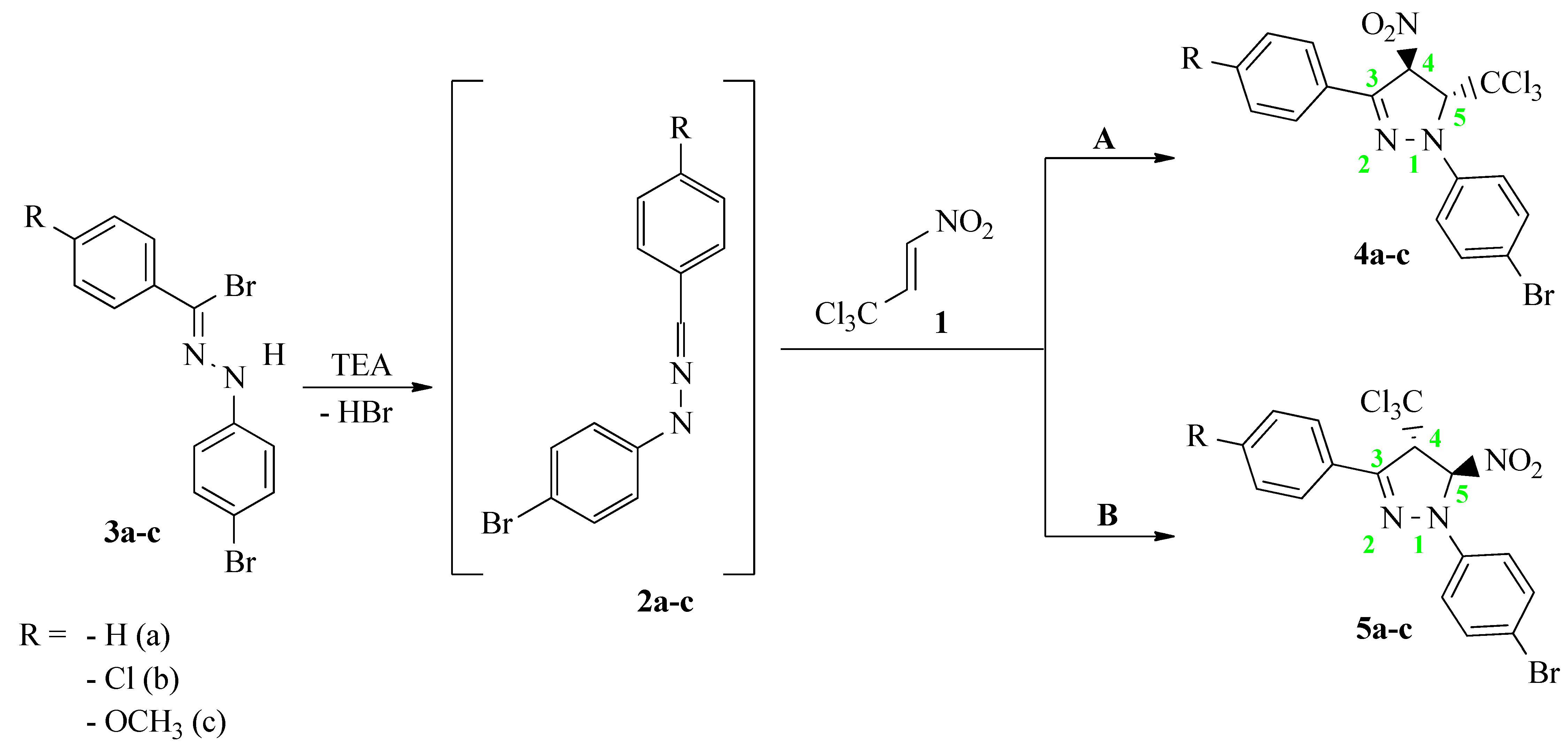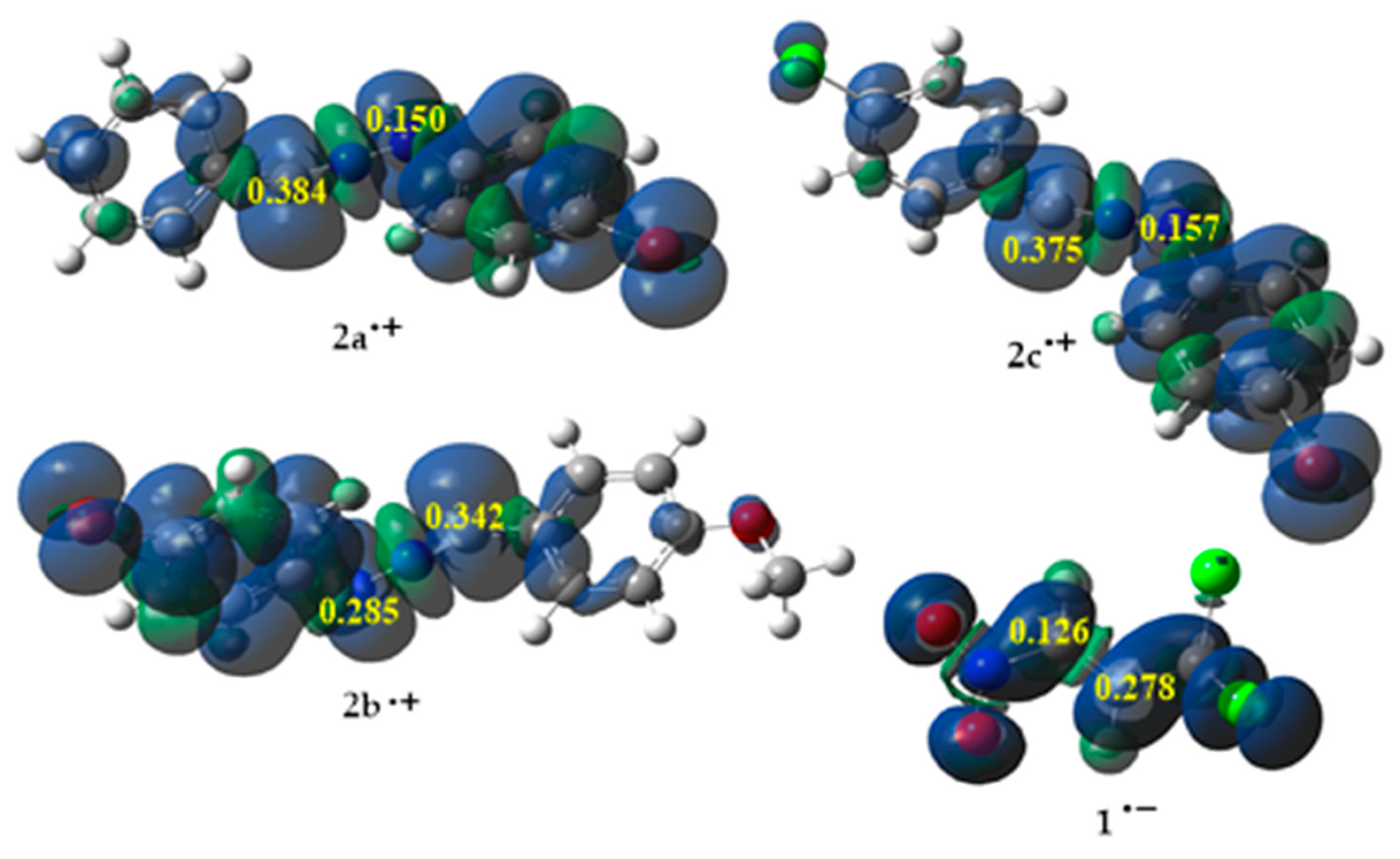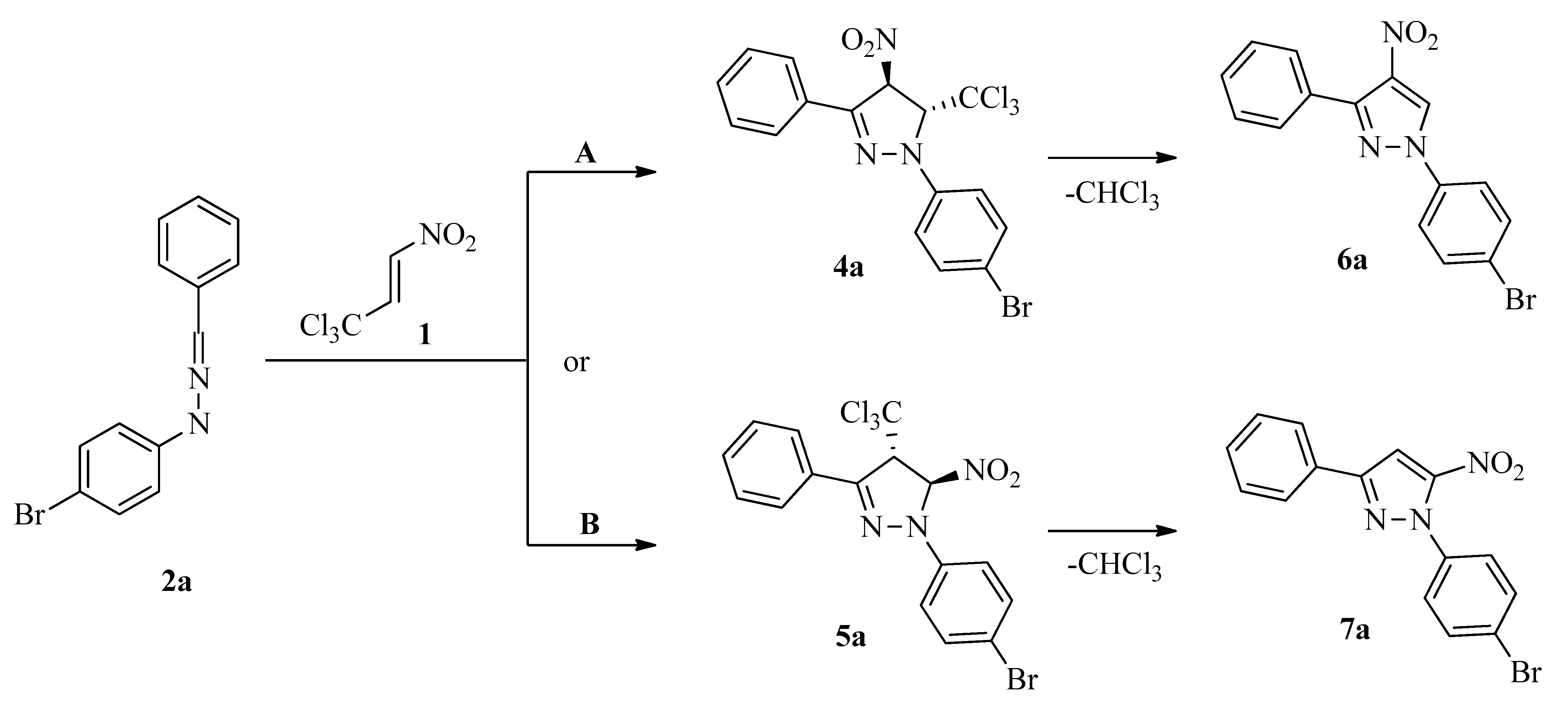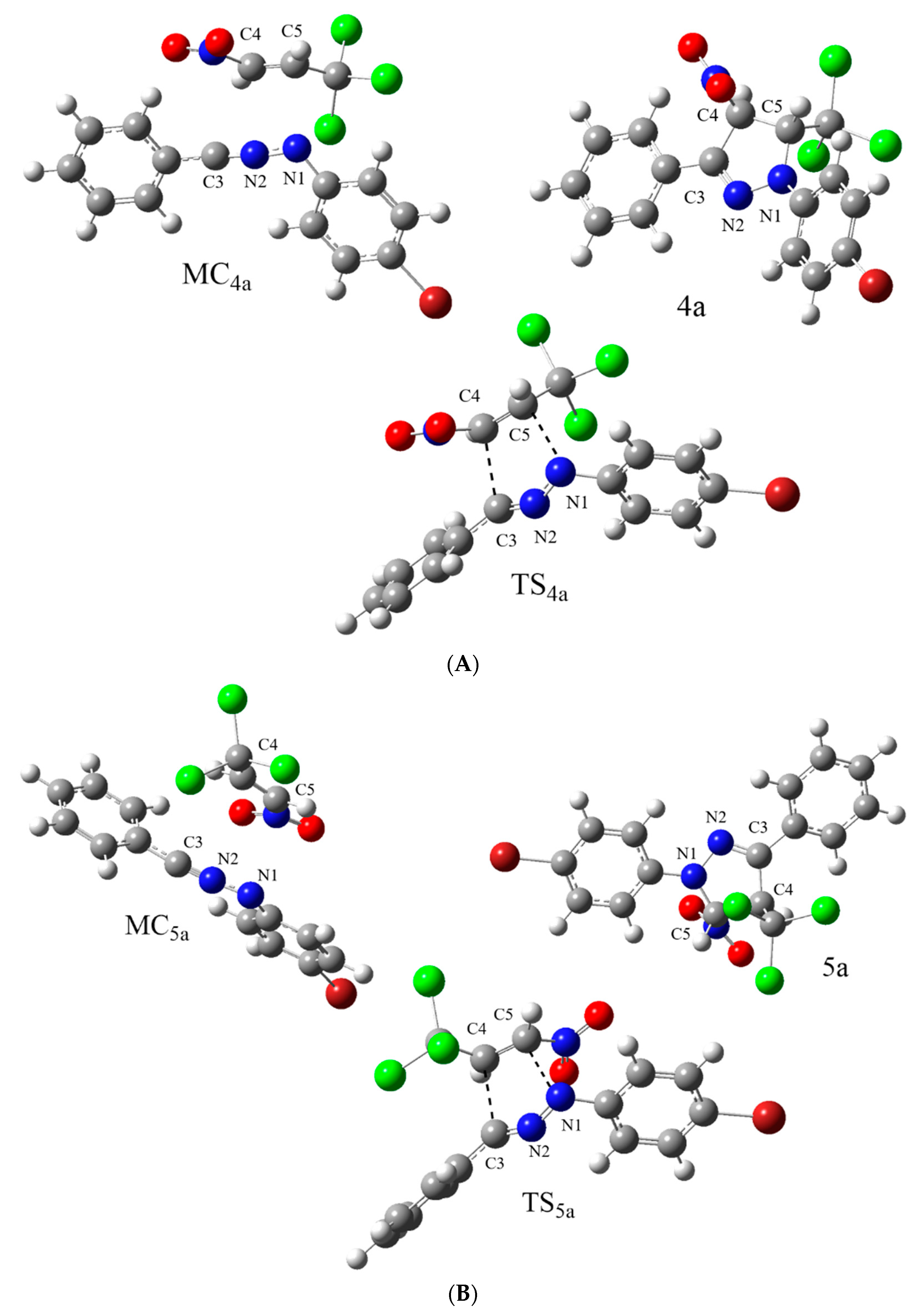On the Question of the Formation of Nitro-Functionalized 2,4-Pyrazole Analogs on the Basis of Nitrylimine Molecular Systems and 3,3,3-Trichloro-1-Nitroprop-1-Ene
Abstract
1. Introduction
2. Result and Discussion
3. Materials and Methods
3.1. Materials
3.2. General Procedure for Cycloaddition Reactions
3.3. Analytical Techniques
3.4. Computational Details
4. Conclusions
Supplementary Materials
Author Contributions
Funding
Institutional Review Board Statement
Informed Consent Statement
Data Availability Statement
Acknowledgments
Conflicts of Interest
Sample Availability
References
- Elkanzi, N.A.A. Review on Synthesis of prazole and pyrazolines. Intent. J. Res. Pharm. Biomed. Sci. 2013, 4, 17–26. [Google Scholar] [CrossRef]
- Kula, K.; Dobosz, J.; Jasiński, R.; Kącka-Zych, A.; Łapczuk-Krygier, A.; Mirosław, B.; Demchuk, O.M. [3+2] Cycloaddition of Diaryldiazomethanes with (E)-3,3,3-Trichloro-1-Nitroprop-1-Ene: An Experimental, Theoretical and Structural Study. J. Mol. Struct. 2020, 1203, 127473. [Google Scholar] [CrossRef]
- Kula, K.; Kącka-Zych, A.; Łapczuk-Krygier, A.; Wzorek, Z.; Nowak, A.K.; Jasiński, R. Experimental and Theoretical Mechanistic Study on the Thermal Decomposition of 3,3-Diphenyl-4-(Trichloromethyl)-5-Nitropyrazoline. Molecules 2021, 26, 1364. [Google Scholar] [CrossRef] [PubMed]
- Johnson, M.; Younglove, B.; Lee, L.; LeBlanc, R.; Holt, H.; Hills, P.; Mackay, H.; Brown, T.; Mooberry, S.L.; Lee, M. Design, Synthesis, and Biological Testing of Pyrazoline Derivatives of Combretastatin-A4. Bioorg. Med. Chem. Lett. 2007, 17, 5897–5901. [Google Scholar] [CrossRef] [PubMed]
- Amir, M.; Kumar, H.; Khan, S.A. Synthesis and Pharmacological Evaluation of Pyrazoline Derivatives as New Anti-Inflammatory and Analgesic Agents. Bioorg. Med. Chem. Lett. 2008, 18, 918–922. [Google Scholar] [CrossRef] [PubMed]
- Kerru, N.; Gummidi, L.; Maddila, S.; Gangu, K.K.; Jonnalagadda, S.B. A Review on Recent Advances in Nitrogen-Containing Molecules and Their Biological Applications. Molecules 2020, 25, 1909. [Google Scholar] [CrossRef]
- Sapnakumari, M.; Narayana, B.; Gurubasavarajswamy, P.M.; Sarojini, B.K. Design, Synthesis, and Pharmacological Evaluation of New Pyrazoline Derivatives. Monatsh. Chem. 2015, 146, 1015–1024. [Google Scholar] [CrossRef]
- Bhandari, S.; Tripathi, A.C.; Saraf, S.K. Novel 2-Pyrazoline Derivatives as Potential Anticonvulsant Agents. Med. Chem. Res. 2013, 22, 5290–5296. [Google Scholar] [CrossRef]
- Oh, L.M. Synthesis of Celecoxib via 1,3-Dipolar Cycloaddition. Tetrahedron Lett. 2006, 47, 7943–7946. [Google Scholar] [CrossRef]
- Wellinga, K.; Grosscurt, A.C.; Van Hes, R. 1-Phenylcarbamoyl-2-Pyrazolines: A New Class of Insecticides. 1. Synthesis and Insecticidal Properties of 3-Phenyl-1-Phenylcarbamoyl-2-Pyrazolines. J. Agric. Food Chem. 1977, 25, 987–992. [Google Scholar] [CrossRef]
- Van Hes, R.; Wellinga, K.; Grosscurt, A.C. 1-Phenylcarbamoyl-2-Pyrazolines: A New Class of Insecticides. 2. Synthesis and Insecticidal Properties of 3,5-Diphenyl-1-Phenylcarbamoyl-2-Pyrazolines. J. Agric. Food Chem. 1978, 26, 915–918. [Google Scholar] [CrossRef]
- Yang, R.; Lv, M.; Xu, H. Synthesis of Piperine Analogs Containing Isoxazoline/Pyrazoline Scaffold and Their Pesticidal Bioactivities. J. Agric. Food Chem. 2018, 66, 11254–11264. [Google Scholar] [CrossRef] [PubMed]
- McCann, S.F.; Annis, G.D.; Shapiro, R.; Piotrowski, D.W.; Lahm, G.P.; Long, J.K.; Lee, K.C.; Hughes, M.M.; Myers, B.J.; Griswold, S.M.; et al. The Discovery of Indoxacarb: Oxadiazines as a New Class of Pyrazoline-Type Insecticides. Pest Manag. Sci. 2001, 57, 153–164. [Google Scholar] [CrossRef] [PubMed]
- von Stein, R.T.; Silver, K.S.; Soderlund, D.M. Indoxacarb, Metaflumizone, and Other Sodium Channel Inhibitor Insecticides: Mechanism and Site of Action on Mammalian Voltage-Gated Sodium Channels. Pestic. Biochem. Physiol. 2013, 106, 101–112. [Google Scholar] [CrossRef]
- Rudolf, M.; Kobus, W. Insecticidal 1-(Phenylcarbamoyl)-2- Pyrazolines. Chem. Abstr. 1973, 79, 584. [Google Scholar]
- Dong, C.; Gao, W.; Li, X.; Sun, S.; Huo, J.; Wang, Y.; Ren, D.; Zhang, J.; Chen, L. Synthesis of Pyrazole-4-Carboxamides as Potential Fungicide Candidates. Mol. Divers. 2021, 25, 2379–2388. [Google Scholar] [CrossRef]
- Zhao, P.L.; Fu, W.; Zhang, M.Z.; Liu, Z.M.; Wei, H.; Yang, G.F. Synthesis, Fungicidal, and Insecticidal Activities of β- Methoxyacrylate-Containing N-Acetyl Pyrazoline Derivatives. J. Agric. Food Chem. 2008, 56, 10767–10773. [Google Scholar] [CrossRef]
- Saber, M. Acute and Population Level Toxicity of Imidacloprid and Fenpyroximate on an Important Egg Parasitoid, Trichogramma Cacoeciae (Hymenoptera: Trichogrammatidae). Ecotoxicology 2011, 20, 1476–1484. [Google Scholar] [CrossRef]
- Gunasekara, A.S.; Truong, T.; Goh, K.S.; Spurlock, F.; Tjeerdema, R.S. Environmental Fate and Toxicology of Fipronil. J. Pestic. Sci. 2007, 32, 189–199. [Google Scholar] [CrossRef]
- Khan, M.A.; Ruberson, J.R. Lethal Effects of Selected Novel Pesticides on Immature Stages of Trichogramma Pretiosum (Hymenoptera: Trichogrammatidae). Pest Manag. Sci. 2017, 73, 2465–2472. [Google Scholar] [CrossRef]
- Charli, A.; Jin, H.; Anantharam, V.; Kanthasamy, A.; Kanthasamy, A.G. Alterations in Mitochondrial Dynamics Induced by Tebufenpyrad and Pyridaben in a Dopaminergic Neuronal Cell Culture Model. Neurotoxicology 2016, 53, 302–313. [Google Scholar] [CrossRef] [PubMed]
- Łapczuk-Krygier, A.; Kącka-Zych, A.; Kula, K. Recent Progress in the Field of Cycloaddition Reactions Involving Conjugated Nitroalkenes. Curr. Chem. Lett. 2019, 8, 13–38. [Google Scholar] [CrossRef]
- Ríos-Gutiérrez, M.; Domingo, L.R. Unravelling the Mysteries of the [3+2] Cycloaddition Reactions. Eur. J. Org. Chem. 2019, 2019, 267–282. [Google Scholar] [CrossRef]
- Verhaeghe, P.; Azas, N.; Hutter, S.; Castera-Ducros, C.; Laget, M.; Dumètre, A.; Gasquet, M.; Reboul, J.-P.; Rault, S.; Rathelot, P.; et al. Synthesis and in Vitro Antiplasmodial Evaluation of 4-Anilino-2-Trichloromethylquinazolines. Bioorg. Med. Chem. 2009, 17, 4313–4322. [Google Scholar] [CrossRef] [PubMed]
- Boguszewska-Czubara, A.; Kula, K.; Wnorowski, A.; Biernasiuk, A.; Popiołek, Ł.; Miodowski, D.; Demchuk, O.M.; Jasiński, R. Novel functionalized β-nitrostyrenes: Promising candidates for new antibacterial drugs. Saudi Pharm. J. 2019, 27, 593–601. [Google Scholar] [CrossRef] [PubMed]
- Alston, T.A.; Porter, D.J.T.; Bright, H.J. The Bioorganic Chemistry of the Nitroalkyl Group. Bioorg. Chem. 1985, 13, 375–403. [Google Scholar] [CrossRef]
- Winkler, R.; Hertweck, C. Biosynthesis of Nitro Compounds. ChemBioChem 2007, 8, 973–977. [Google Scholar] [CrossRef]
- Raether, W.; Hänel, H. Nitroheterocyclic Drugs with Broad Spectrum Activity. Parasitol. Res. 2003, 90, 19–39. [Google Scholar] [CrossRef]
- Fryźlewicz, A.; Łapczuk-Krygier, A.; Kula, K.; Demchuk, O.M.; Dresler, E.; Jasiński, R. Regio- and Stereoselective Synthesis of Nitrofunctionalized 1,2-Oxazolidine Analogs of Nicotine. Chem. Heterocycl. Compd. 2020, 56, 120–122. [Google Scholar] [CrossRef]
- Jasiński, R.; Mróz, K.; Kącka, A. Experimental and Theoretical DFT Study on Synthesis of Sterically Crowded 2,3,3,(4)5-Tetrasubstituted-4-Nitroisoxazolidines via 1,3-Dipolar Cycloaddition Reactions Between Ketonitrones and Conjugated Nitroalkenes. J. Heterocycl. Chem. 2016, 53, 1424–1429. [Google Scholar] [CrossRef]
- Jasiński, R.; Mróz, K. Kinetic Aspects of [3+2] Cycloaddition Reactions between (E)-3,3,3-Trichloro-1-Nitroprop-1-Ene and Ketonitrones. React. Kinet. Mech. Catal. 2015, 116, 35–41. [Google Scholar] [CrossRef]
- Zawadzińska, K.; Ríos-Gutiérrez, M.; Kula, K.; Woliński, P.; Mirosław, B.; Krawczyk, T.; Jasiński, R. The Participation of 3,3,3-Trichloro-1-Nitroprop-1-Ene in the [3+2] Cycloaddition Reaction with Selected Nitrile N-Oxides in the Light of the Experimental and MEDT Quantum Chemical Study. Molecules 2021, 26, 6774. [Google Scholar] [CrossRef] [PubMed]
- Kula, K.; Zawadzińska, K. Local Nucleophile-Electrophile Interactions in [3+2] Cycloaddition Reactions between Benzonitrile N-Oxide and Selected Conjugated Nitroalkenes in the Light of MEDT Computational Study. Curr. Chem. Lett. 2021, 10, 9–16. [Google Scholar] [CrossRef]
- Jasiński, R. One-Step versus Two-Step Mechanism of Diels-Alder Reaction of 1-Chloro-1-Nitroethene with Cyclopentadiene and Furan. J. Mol. Graph. Model. 2017, 75, 55–61. [Google Scholar] [CrossRef]
- Żmigrodzka, M.; Sadowski, M.; Dresler, E.; Demchuk, O.M.; Kula, K. Polar [3+2] Cycloaddition between N-Methyl Azomethine Ylide and Trans-3,3,3-Trichloro-1- Nitroprop-1-Ene. Sci. Rad. 2022, 1, 26–35. [Google Scholar] [CrossRef]
- Żmigrodzka, M.; Dresler, E.; Hordyjewicz-Baran, Z.; Kulesza, R.; Jasiński, R. A Unique Example of Noncatalyzed [3+2] Cycloaddition involving (2E)-3-Aryl-2-Nitroprop-2-Enenitriles. Chem. Heterocycl. Compd. 2017, 53, 1161–1162. [Google Scholar] [CrossRef]
- Barkov, A.; Zimnitskiy, N.; Korotaev, V.; Kutyashev, I.; Moshkin, V.; Sosnovskikh, V. Highly regio- and stereoselective 1,3-dipolar cycloaddition of stabilised azomethine ylides to 3,3,3-trihalogeno-1-nitropropenes: Synthesis of trihalomethylated spiro[indoline-3,2′-pyrrolidin]-2-ones and spiro[indoline-3,3′-pyrrolizin]-2-ones. Tetrahedron 2016, 72, 6825–6836. [Google Scholar] [CrossRef]
- Korotaev, V.Y.; Sosnovskikh, V.Y.; Kutyashev, I.B.; Barkov, A.Y.; Matochkina, E.G.; Kodess, M.I. A simple and convenient synthesis of 4-methyl-3-nitro-2-trihalomethyl-2H-chromenes from N-unsubstituted imines of 2-hydroxyacetophenones and trichloro (trifluoro) ethylidene nitromethanes. Tetrahedron 2008, 64, 5055–5060. [Google Scholar] [CrossRef]
- Golushko, A.A.; Sandzhieva, M.A.; Ivanov, A.Y.; Boyarskaya, I.A.; Khoroshilova, O.V.; Barkov, A.Y.; Vasilyev, A.V. Reactions of 3,3,3-Trihalogeno-1-nitropropenes with Arenes in the Superacid CF3SO3H: Synthesis of (Z)-3, 3, 3-Trihalogeno-1,2-diarylpropan-1-one Oximes and Study on the Reaction Mechanism. J. Org. Chem. 2018, 83, 10142–10157. [Google Scholar] [CrossRef]
- Golushko, A.A.; Khoroshilova, O.V.; Vasilyev, A.V. Synthesis of 1, 2, 4-oxadiazoles by tandem reaction of nitroalkenes with arenes and nitriles in the superacid TfOH. J. Org. Chem. 2019, 84, 7495–7500. [Google Scholar] [CrossRef]
- Domingo, L.R. Molecular Electron Density Theory: A Modern View of Reactivity in Organic Chemistry. Molecules 2016, 21, 1319. [Google Scholar] [CrossRef] [PubMed]
- Domingo, L.R.; Ríos-Gutiérrez, M.; Pérez, P. Applications of the Conceptual Density Functional Theory Indices to Organic Chemistry Reactivity. Molecules 2016, 21, 748. [Google Scholar] [CrossRef]
- Parr, R.G.; Yang, W. Density Functional Theory of Atoms and Molecules, 1st ed.; Oxford University Press: New York, NY, USA, 1989. [Google Scholar]
- Parr, R.G.; Szentpály, L.v.; Liu, S. Electrophilicity Index. J. Am. Chem. Soc. 1999, 121, 1922–1924. [Google Scholar] [CrossRef]
- Domingo, L.R.; Kula, K.; Ríos-Gutiérrez, M. Unveiling the Reactivity of Cyclic Azomethine Ylides in [3+2] Cycloaddition Reactions within the Molecular Electron Density Theory. Eur. J. Org. Chem. 2020, 2020, 5938–5948. [Google Scholar] [CrossRef]
- Mlostoń, G.; Kula, K.; Jasiński, R. A DFT Study on the Molecular Mechanism of Additions of Electrophilic and Nucleophilic Carbenes to Non-Enolizable Cycloaliphatic Thioketones. Molecules 2021, 26, 5562. [Google Scholar] [CrossRef] [PubMed]
- Domingo, L.R.; Kula, K.; Ríos-Gutiérrez, M.; Jasiński, R. Understanding the Participation of Fluorinated Azomethine Ylides in Carbenoid-Type [3 + 2] Cycloaddition Reactions with Ynal Systems: A Molecular Electron Density Theory Study. J. Org. Chem. 2021, 86, 12644–12653. [Google Scholar] [CrossRef]
- Domingo, L.R.; Ríos-Gutiérrez, M.; Silvi, B.; Pérez, P. The Mysticism of Pericyclic Reactions: A Contemporary Rationalisation of Organic Reactivity Based on Electron Density Analysis. Eur. J. Org. Chem. 2018, 2018, 1107–1120. [Google Scholar] [CrossRef]
- Domingo, L.R.; Chamorro, E.; Pérez, P. Understanding the reactivity of captodative ethylenes in polar cycloaddition reactions. A theoretical study. J. Org. Chem. 2008, 73, 4615–4624. [Google Scholar] [CrossRef]
- Domingo, L.R.; Ríos-Gutiérrez, M. Conceptual Density Functional Theory; Liu, S., Ed.; Wiley VCH GmbH: Weinheim, Germany, 2022; Chapter 24. [Google Scholar]
- Fryźlewicz, A.; Olszewska, A.; Zawadzińska, K.; Woliński, P.; Kula, K.; Kącka-Zych, A.; Łapczuk-Krygier, A.; Jasiński, R. On the Mechanism of the Synthesis of Nitrofunctionalised Δ2-Pyrazolines via [3+2] Cycloaddition Reactions between α-EWG-Activated Nitroethenes and Nitrylimine TAC Systems. Organics 2022, 3, 59–76. [Google Scholar] [CrossRef]
- Aurell, M.J.; Domingo, L.R.; Pérez, P.; Contreras, R. A theoretical study on the regioselectivity of 1,3-dipolar cycloadditions using DFT-based reactivity indexes. Tetrahedron 2004, 60, 11503–11509. [Google Scholar] [CrossRef]
- Mlostoń, G.; Jasiński, R.; Kula, K.; Heimgartner, H. A DFT Study on the Barton-Kellogg Reaction—The Molecular Mechanism of the Formation of Thiiranes in the Reaction between Diphenyldiazomethane and Diaryl Thioketones. Eur. J. Org. Chem. 2020, 2020, 176–182. [Google Scholar] [CrossRef]
- Kula, K.; Kącka-Zych, A.; Łapczuk-Krygier, A.; Jasiński, R. Analysis of the Possibility and Molecular Mechanism of Carbon Dioxide Consumption in the Diels-Alder Processes. Pure Appl. Chem. 2021, 93, 427–446. [Google Scholar] [CrossRef]
- Domingo, L.R.; Pérez, P.; Sáez, J.A. Understanding the Local Reactivity in Polar Organic Reactions through Electrophilic and Nucleophilic Parr Functions. RSC Adv. 2013, 3, 1486–1494. [Google Scholar] [CrossRef]
- Ioffe, B.V. Characteristic Frequencies in the Infrared Spectra of Pyrazolines. Chem. Heterocycl. Compd. 1971, 4, 791–793. [Google Scholar] [CrossRef]
- Jasiński, R. In the Searching for Zwitterionic Intermediates on Reaction Paths of [3 + 2] Cycloaddition Reactions between 2,2,4,4-Tetramethyl-3-Thiocyclobutanone S-Methylide and Polymerizable Olefins. RSC Adv. 2015, 5, 101045–101048. [Google Scholar] [CrossRef]
- Jasiński, R. A Stepwise, Zwitterionic Mechanism for the 1,3-Dipolar Cycloaddition between (Z)-C-4-Methoxyphenyl-N-Phenylnitrone and Gem-Chloronitroethene Catalysed by 1-Butyl-3-Methylimidazolium Ionic Liquid Cations. Tetrahedron Lett. 2015, 56, 532–535. [Google Scholar] [CrossRef]
- Kula, K.; Łapczuk-Krygier, A. A DFT computational study on the [3+2] cycloaddition between parent thionitrone and nitroethene. Curr. Chem. Lett. 2018, 7, 27–34. [Google Scholar] [CrossRef]
- Kącka-Zych, A.; Pérez, P. Perfluorobicyclo[2.2.0]Hex-1(4)-Ene as Unique Partner for Diels–Alder Reactions with Benzene: A Density Functional Theory Study. Theor. Chem. Acc. 2021, 140, 17. [Google Scholar] [CrossRef]
- Kącka-Zych, A.; Jasiński, R. Molecular Mechanism of Hetero Diels-Alder Reactions between (E)-1,1,1-Trifluoro-3-Nitrobut-2-Enes and Enamine Systems in the Light of Molecular Electron Density Theory. J. Mol. Graph. Model. 2020, 101, 107714. [Google Scholar] [CrossRef]
- Demchuk, O.M.; Jasiński, R.; Pietrusiewicz, K.M. New Insights into the Mechanism of Reduction of Tertiary Phosphine Oxides by Means of Phenylsilane. Heteroat. Chem. 2015, 26, 441–448. [Google Scholar] [CrossRef]
- Alnajjar, R.A.; Jasiński, R. Competition between [2+1]- and [4+1]-Cycloaddition Mechanisms in Reactions of Conjugated Nitroalkenes with Dichlorocarbene in the Light of a DFT Computational Study. J. Mol. Model. 2019, 25, 157. [Google Scholar] [CrossRef] [PubMed]
- Kącka-Zych, A.; Jasiński, R. Mechanistic Aspects of the Synthesis of Seven-membered Internal Nitronates via Stepwise [4 + 3] Cycloaddition Involving Conjugated Nitroalkenes: Molecular Electron Density Theory Computational Study. J. Comput. Chem. 2022, 43, 1221–1228. [Google Scholar] [CrossRef] [PubMed]
- Domingo, L.R. A New C–C Bond Formation Model Based on the Quantum Chemical Topology of Electron Density. RSC Adv. 2014, 4, 32415–32428. [Google Scholar] [CrossRef]
- Jasiński, R.; Dresler, E. On the Question of Zwitterionic Intermediates in the [3+2] Cycloaddition Reactions: A Critical Review. Organics 2020, 1, 49–69. [Google Scholar] [CrossRef]
- Shawali, A.S.; Farghaly, T.A.; Hussein, S.M.; Abdalla, M.M. Site-Selective Reactions of Hydrazonoyl Chlorides with Cyanoacetic Hydrazide and Its N-Arylidene Derivatives and Anti-Aggressive Activity of Prepared Products. Arch. Pharm. Res. 2013, 36, 694–701. [Google Scholar] [CrossRef]
- Zhang, Y.; Liu, W.; Zhao, Z. Nucleophilic Trapping Nitrilimine Generated by Photolysis of Diaryltetrazole in Aqueous Phase. Molecules 2013, 19, 306–315. [Google Scholar] [CrossRef] [PubMed]
- Perekalin, W.; Lipina, E.S.; Berestovitskaya, V.; Efremov, D.A. Nitroalkenes: Conjugated Nitro Compounds; Wiley: New York, NY, USA, 1994; ISBN 0471943185. [Google Scholar]
- Beheshti, A.; Kamalzadeha, Z.; Haj-Maleka, M.; Payaba, M.; Rezvanfar, M.A.; Siadati, S.A. Development and Validation of a Reversed-Phase HPLC Method for Determination of Assay Content of Teriflunomide by the Aid of BOMD Simulations. Curr. Chem. Lett. 2021, 10, 281–294. [Google Scholar] [CrossRef]
- Siadati, S.A.; Rezvanfar, M.A.; Payab, M.; Beheshti, A. Development and Validation of a Short Runtime Method for Separation of Trace Amounts of 4-Aminophenol, Phenol, 3-Nitrosalicylic Acid and Mesalamine by Using HPLC System. Curr. Chem. Lett. 2021, 10, 151–160. [Google Scholar] [CrossRef]
- Demchuk, O.M.; Jasiński, R.; Strzelecka, D.; Dziuba, K.; Kula, K.; Chrzanowski, J.; Krasowska, D. A clean and simple method for deprotection of phosphines from borane complexes. Pure Appl. Chem. 2018, 90, 49–62. [Google Scholar] [CrossRef]
- Frisch, M.J.; Trucks, G.W.; Schlegel, H.B.; Scuseria, G.E.; Robb, M.A.; Cheeseman, J.R.; Scalmani, G.; Barone, V.; Mennucci, B. GAUSSIAN 09, Revision, C.01; Gaussian, Inc.: Wallingford, CT, USA, 2009. [Google Scholar]
- Hehre, M.J.; Radom, L.; Schleyer, P.v.R.; Pople, J. Ab Initio Molecular Orbital Theory; Wiley: New York, NY, USA, 1986. [Google Scholar]
- Grimme, S.; Antony, J.; Ehrlich, S.; Krieg, H. A Consistent and Accurate Ab Initio Parametrization of Density Functional Dispersion Correction (DFT-D) for the 94 Elements H-Pu. J. Chem. Phys. 2010, 132, 154104. [Google Scholar] [CrossRef]
- Zawadzińska, K.; Kula, K. Application of β-Phosphorylated Nitroethenes in [3+2] Cycloaddition Reactions Involving Benzonitrile N-Oxide in the Light of a DFT Computational Study. Organics 2021, 2, 26–37. [Google Scholar] [CrossRef]
- Fukui, K. Formulation of the Reaction Coordinate. J. Phys. Chem. 1970, 74, 4161–4163. [Google Scholar] [CrossRef]
- Tapia, O. Solvent Effect Theories: Quantum and Classical Formalisms and Their Applications in Chemistry and Biochemistry. J. Math. Chem. 1992, 10, 139–181. [Google Scholar] [CrossRef]
- Tomasi, J.; Persico, M. Molecular Interactions in Solution: An Overview of Methods Based on Continuous Distributions of the Solvent. Chem. Rev. 1994, 94, 2027–2094. [Google Scholar] [CrossRef]
- Cossi, M.; Barone, V.; Cammi, R.; Tomasi, J. Ab Initio Study of Solvated Molecules: A New Implementation of the Polarizable Continuum Model. Chem. Phys. Lett. 1996, 255, 327–335. [Google Scholar] [CrossRef]
- Dennington, R.; Keith, T.A.; Millam, J.M. GaussView, Version 6.0; Semichem Inc.: Shawnee Mission, KS, USA, 2016. [Google Scholar]




| Reagent | μ | η | ω | N |
|---|---|---|---|---|
| 1 | −5.84 | 5.22 | 3.27 | 0.66 |
| 2a | −3.32 | 3.84 | 1.66 | 3.76 |
| 2b | −3.51 | 3.70 | 1.84 | 3.86 |
| 2c | −3.55 | 3.42 | 1.43 | 3.88 |
| Temperature [°C] | Solvent | Reaction Time [h] | Catalyst | Yield [%] |
|---|---|---|---|---|
| 25 | Benzene | 6 | - | - |
| 25 | Benzene | 24 | - | - |
| 25 | Benzene | 6 | Et3N | 93 |
| 80 | Benzene | 6 | Et3N | 65 |
| 25 | Benzene | 6 | n-PrNH2 | 70 |
| 25 | Benzene | 6 | CsCO3 | Trace |
| 80 | Benzene | 6 | CsCO3 | Trace |
| Path | Transition | ΔH | ΔG | ΔS |
|---|---|---|---|---|
| A | 1 + 2a → MC4a | −6.61 | 3.32 | −42.41 |
| 1 + 2a → TS4a | −0.74 | 11.52 | −50.26 | |
| 1 + 2a → 4a | −64.91 | −50.90 | −56.14 | |
| B | 1 + 2a → MC5a | −8.80 | 0.69 | −40.97 |
| 1 + 2a → TS5a | −2.25 | 10.50 | −51.90 | |
| 1 + 2a → 5a | −67.06 | −53.01 | −56.26 |
| C3-C4 r [Å] | lC3-C4 | C5-N1 r [Å] | lC5-N1 | Δl | GEDT [e] | |
|---|---|---|---|---|---|---|
| MC4a | 3.260 | 3.033 | 0.03 | |||
| TS4a | 2.242 | 0.521 | 2.355 | 0.378 | 0.14 | 0.17 |
| 4a | 1.516 | 1.452 | ||||
| MC5a | 3.333 | 3.033 | 0.03 | |||
| TS5a | 2.275 | 0.509 | 2.383 | 0.309 | 0.20 | 0.20 |
| 5a | 1.526 | 1.409 |
Publisher’s Note: MDPI stays neutral with regard to jurisdictional claims in published maps and institutional affiliations. |
© 2022 by the authors. Licensee MDPI, Basel, Switzerland. This article is an open access article distributed under the terms and conditions of the Creative Commons Attribution (CC BY) license (https://creativecommons.org/licenses/by/4.0/).
Share and Cite
Kula, K.; Łapczuk, A.; Sadowski, M.; Kras, J.; Zawadzińska, K.; Demchuk, O.M.; Gaurav, G.K.; Wróblewska, A.; Jasiński, R. On the Question of the Formation of Nitro-Functionalized 2,4-Pyrazole Analogs on the Basis of Nitrylimine Molecular Systems and 3,3,3-Trichloro-1-Nitroprop-1-Ene. Molecules 2022, 27, 8409. https://doi.org/10.3390/molecules27238409
Kula K, Łapczuk A, Sadowski M, Kras J, Zawadzińska K, Demchuk OM, Gaurav GK, Wróblewska A, Jasiński R. On the Question of the Formation of Nitro-Functionalized 2,4-Pyrazole Analogs on the Basis of Nitrylimine Molecular Systems and 3,3,3-Trichloro-1-Nitroprop-1-Ene. Molecules. 2022; 27(23):8409. https://doi.org/10.3390/molecules27238409
Chicago/Turabian StyleKula, Karolina, Agnieszka Łapczuk, Mikołaj Sadowski, Jowita Kras, Karolina Zawadzińska, Oleg M. Demchuk, Gajendra Kumar Gaurav, Aneta Wróblewska, and Radomir Jasiński. 2022. "On the Question of the Formation of Nitro-Functionalized 2,4-Pyrazole Analogs on the Basis of Nitrylimine Molecular Systems and 3,3,3-Trichloro-1-Nitroprop-1-Ene" Molecules 27, no. 23: 8409. https://doi.org/10.3390/molecules27238409
APA StyleKula, K., Łapczuk, A., Sadowski, M., Kras, J., Zawadzińska, K., Demchuk, O. M., Gaurav, G. K., Wróblewska, A., & Jasiński, R. (2022). On the Question of the Formation of Nitro-Functionalized 2,4-Pyrazole Analogs on the Basis of Nitrylimine Molecular Systems and 3,3,3-Trichloro-1-Nitroprop-1-Ene. Molecules, 27(23), 8409. https://doi.org/10.3390/molecules27238409












